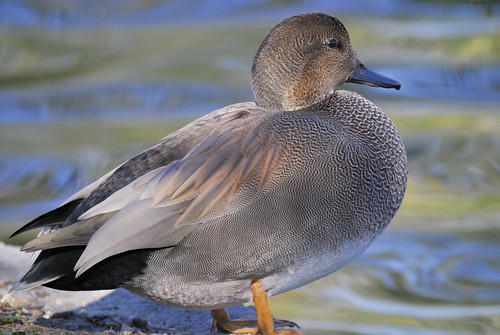tags: Gadwall, Anas strepera, birds, mystery bird, bird ID quiz
[Mystery birds] Gadwall drake, Anas strepera, photographed in Hermann Park, Texas. [I will identify this bird for you tomorrow]
Image: Joseph Kennedy, 16 November 2008 [larger view].
Nikon D200 Kowa 883 telescope with TSN-PZ camera eyepiece 1/180s f/1.0 iso400.
Please name at least one field mark that supports your identification.
Rick Wright, Managing Director of WINGS Birding Tours Worldwide, writes:
What seems at first a dull duck becomes on closer inspection a marvelously subtle beauty, delicately variegated grays and browns and chestnuts joining in the unique aspect of a drake Gadwall.
The bird's classic field mark, the white square on the secondaries, is invisible in this image, as it often is in the field. But what is visible is good enough: the black rear quarters edge directly on the silvery gray of the flank, with no hint of the white "fender patch" that separates the undertail from the remainder of the underparts on other dabblers. The gray of the body plumage is elegantly vermiculated, the long scapulars handsomely accented with chestnut and the tertials bright silvery gray. The neatly scalloped breast is set off from a clear white belly, a pattern helpful in birds overhead.
The head may be the plainest part of a male Gadwall's plumage, but what it lacks in feathery pizzazz it makes up for in its extravagant shape. The nape is full and puffy, the crown flat, the forehead noticeably steep; the dark bill is long and slender. Female Gadwall, which can look very much like Mallards, are often more readily identified by their head shape than any plumage character.
The real mystery to this bird is perhaps not its identity but its name. The word "gadwall" is usually said to be echoic of the male's nasal, buzzy call, a familiar sound on wintertime ponds and lakes. Seems unlikely to me. Any better ideas out there?
- Log in to post comments


I believe that's a male Gadwall. It's a bird I tended to overlook when I first started bird watching, but I've come to appreciate the subtle attractiveness of the male, and this photo certainly highlights that.
For field marks, I recognize the male Gadwall by the dark, speckled chest contrasting with the rest of its body, along with the relatively nondescript head and that black at the tail end. Consulting Sibley, I see that there are a number of other things to look for that show up prominently in this photo, like the silvery tertials and, though they're not mentioned specifically by Sibley, those really pretty, if subtle, brownish feathers (are they scapulars?) that overlay the folded wings.
From a distance, this bird is easily identified by it's overall plain look contrasted by the black tail feathers.
Close up, as in this photo, I find the Gadwall anything but plain.
The scapulars are (usually) brightly colored secondaries. The Gadwall's are white, they're not visible in this photo.
Definitely a Gadwall, Head shape and black rump
Definitely a Gadwall, Head shape and black rump
a fellow ranger calls the gadwalls "old money" -- nothing flashy, but ostentatious in a quiet way... just so everyone understands, she has also defined wood ducks as "new money" - nothing but flash :)
Feather terminology:
http://www.kidwings.com/bodyparts/topography/index.htm
The illustration is a passerine, of course, but drop it horizontally into a bathtub and you have a duck. Big Sibley also has fine diagrams of ducks on the water.
In this image, I see a dull whitish tail. The uppertail and undertail coverts and rump and vent are black. The primaries are dull gray. The tertials are bright gray. The scapulars are pink.
Thank you for the clarification and pointers to feather topography. I've been working lately on improving the specificity of my feather descriptions, and obviously I backslid a bit in my earlier comment, referring to this bird's black at the "tail end", when in fact I know that the tail itself is lighter, and that it's the uppertail and undertail coverts that I was talking about. I'm finding that now that I'm spending more time with specialty photographic guides, I really need to understand exactly what feathers the captions are referring to.
I wrestled with what term to use for the shade of this bird's scapulars. I knew that "brownish" was a weak choice, since it encompasses so many different shades, but couldn't think of a more-specific term that captured what I was seeing in the photo. "Caramel-colored", maybe? I'd have a hard time seeing the shade in this photo as "pink", but maybe that's a more accurate description of what the bird really looks like, and this photo has a lighting anomaly that interferes with my seeing it that way? Or maybe I just don't understand what "pink" really means as applied to bird plumages?
Anyway, thanks again for the clarifications.
I usually ID gadwalls by the head shape, too, as well as the overall "plain look" (to use Kamaka's phrase). In this photo, it was the plumage that gave me the ID, as the head shape was a bit tricky due to the angle of the photo.
I just call this his Speedo.